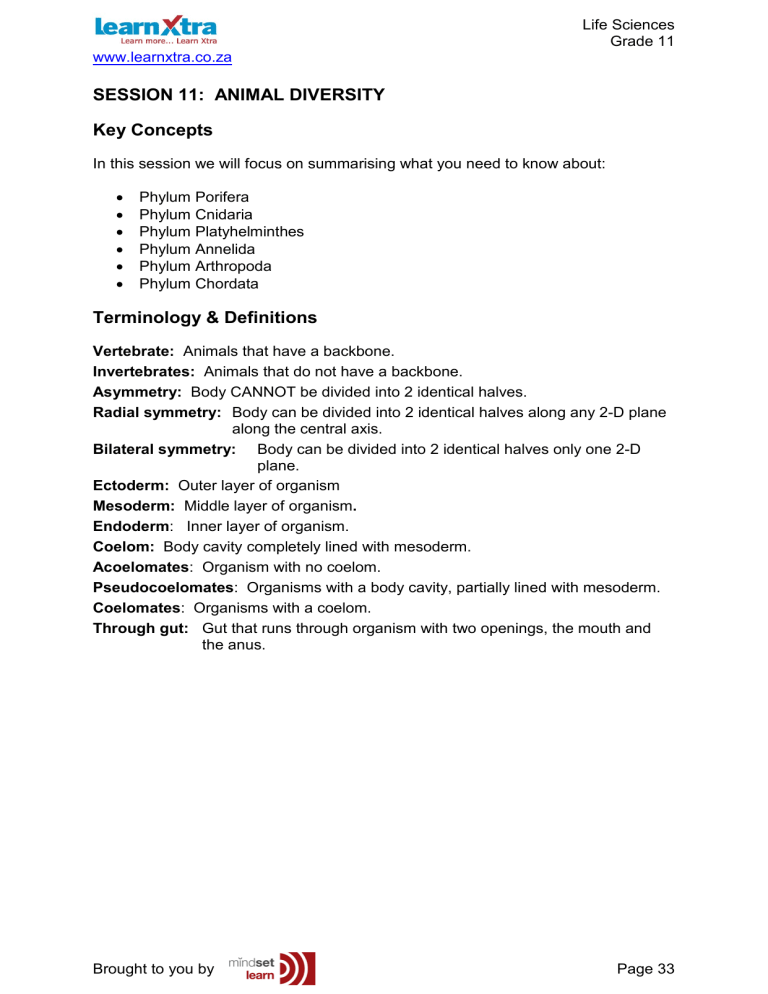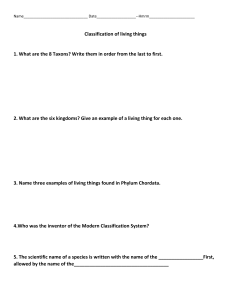
Life Sciences Grade 11 www.learnxtra.co.za SESSION 11: ANIMAL DIVERSITY Key Concepts In this session we will focus on summarising what you need to know about: • • • • • • Phylum Porifera Phylum Cnidaria Phylum Platyhelminthes Phylum Annelida Phylum Arthropoda Phylum Chordata Terminology & Definitions Vertebrate: Animals that have a backbone. Invertebrates: Animals that do not have a backbone. Asymmetry: Body CANNOT be divided into 2 identical halves. Radial symmetry: Body can be divided into 2 identical halves along any 2-D plane along the central axis. Bilateral symmetry: Body can be divided into 2 identical halves only one 2-D plane. Ectoderm: Outer layer of organism Mesoderm: Middle layer of organism. Endoderm: Inner layer of organism. Coelom: Body cavity completely lined with mesoderm. Acoelomates: Organism with no coelom. Pseudocoelomates: Organisms with a body cavity, partially lined with mesoderm. Coelomates: Organisms with a coelom. Through gut: Gut that runs through organism with two openings, the mouth and the anus. Brought to you by Page 33 Life Sciences Grade 11 www.learnxtra.co.za Key Concepts / Diagram Phylum Porifera The organisms in this phylum are filter feeders with a simple, porous body. The body contains specialised cells called choanocytes and amoebocytes. A small place of sponge can regenerate into an entire new organism. These organisms are asymmetrical, have no tissue, no coelom and no through-gut. Phylum Cnidaria The organisms of this phylum are the simplest animals with tissues. It takes on two forms: polyps, e.g. hydra, corals, and sea anemones and medusas, e.g. blue bottles, jelly fish. These organisms have a radial symmetry, have 2 tissue layers, no coelom and no through-gut. Phylum Platyhelminthes The organisms of this phylum are called flat worms. They have a muscular feeding tube. The complete gut is branching, sac-like and surrounded by tissues, not a body cavity. These organisms have a bilateral symmetry, have 3 tissue layers, no coelom and no through-gut. Phylum Annelida The organisms of this phylum are called round worms. They have a closed circulatory system and a complete digestive system and thus a through gut. The nervous and fluid-balance systems are well-developed. They have a coelom which serves as a hydrostatic skeleton against which muscles operate. These worms have a bilateral symmetry and three tissue layers. Phylum Arthropoda This is the largest phylum of animals. The nervous system is well developed. They have a complete digestive system and thus a through gut. They have an open circulatory system and a reduced coelom which is a blood-filled space called haemocoel. These organisms have a bilateral symmetry and three tissue layers. The protective exoskeleton is made of chitin. Phylum Chordata This phylum has a notochord that becomes a vertebral column which is part of the endoskeleton. A hollow, dorsal nerve cord is present. Pharyngeal (gill) slits are present in all during embryonic development and they have a post-anal tail. They have a closed circulatory system and a complete digestive system and thus a through gut. The nervous and fluid-balance systems are well developed. They have a coelom present. All chordata have a bilateral symmetry and three tissue layers. Brought to you by Page 34 Life Sciences Grade 11 www.learnxtra.co.za X-planation The table below provides a summary of the most important content required for examination purposes. Adaptations Symmetry Number of tissue layers Coelom Through gut Skeleton Porifera Asymmetry One Acoelomate No None Cnidaria Radial Two Acoelomate One opening None Platyhelminthes Bilateral Three Acoelomate One opening None Annelida Bilateral Three Coelomate Present Hydroskeleton Arthropoda Bilateral Three Coelomate Present Exoskeleton Chordata Bilateral Three Coelomate Present Endoskeleton Animal Group Brought to you by Page 35 Life Sciences Grade 11 www.learnxtra.co.za X-ample Questions Question 1 1.1 Choose an item/word from COLUMN B that matches a description in COLUMN A. Write only the LETTER (A – J) next to the question number (1.3.1. – 1.3.6.) For example 1.3.8. N. 1.1. COLUMN A Phylum of the fish. 1.2. Animals that have amoebocytes. 1.3. Segmented worms. 1.4. A group of animals with a definite vertebral column and an internal skeleton 1.5. Animals with an exoskeleton. 1.6. Bilateral worms with coelom. A B C D E F G H I J COLUMN B Molluscs Annelida Placentals Notochord Vertebrates Chondrichthyes Osteichthyes Chordata Arthropoda Porifera (6) Question 2 Study the diagrams below and answer the questions that follow. A B C 2.1 To which kingdom do all the organisms above belong? (2) 2.2 List 3 characteristics of the kingdom mentioned in 2.1. (6) 2.3 Identify the organism labelled A. (1) 2.4 Identify the phylum of organism A. (1) 2.5 List 5 characteristics of the phylum of organism A. (5) 2.6 Identify the organism labelled B. (1) 2.7 Identify the phylum of organism B. (1) 2.8 List 5 characteristics of the phylum of organism B. (5) 2.9 Identify the organism labelled C. (1) 2.10 Identify the phylum of organism C. (1) 2.11 List 5 characteristics of the phylum of organism C. (5) Brought to you by Page 36


